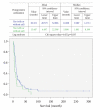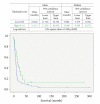Efficacy of decompression and fixation for metastatic spinal cord compression: analysis of factors prognostic for survival and postoperative ambulation
- PMID: 22259690
- PMCID: PMC3259463
- DOI: 10.3340/jkns.2011.50.5.434
Efficacy of decompression and fixation for metastatic spinal cord compression: analysis of factors prognostic for survival and postoperative ambulation
Abstract
Objective: The goals of surgical intervention for metastatic spinal cord compression (MSCC) are prolonging survival and improving quality of life. Non-ambulatory paraplegic patients, either at presentation or after treatment, have a much shorter life expectancy than ambulatory patients. We therefore analyzed prognostic factors for survival and postoperative ambulation in patients surgically treated for MSCC.
Methods: We assessed 103 patients with surgically treated MSCC who presented with lower extremity weakness between January 2001 and December 2008. Factors prognostic for overall survival (OS) and postoperative ambulation, including surgical method, age, sex, primary tumor site, metastatic spinal site, surgical levels, Tokuhashi score, and treatment with chemo- or radiation therapy, were analyzed retrospectively.
Results: Median OS was significantly longer in the postoperatively ambulatory group [11.0 months; 95% confidence interval (CI), 9.29-12.71 months] than in the non-ambulatory group (5.0 months; 95% CI, 1.80-8.20 months) (p=0.035). When we compared median OS in patients with high (9-11) and low (0-8) Tokuhashi scores, they were significantly longer in the former (15.0 months; 95% CI, 9.29-20.71 months vs. 9.0 months; 95% CI, 7.48-10.52 months; p=0.003). Multivariate logistic regression analysis showed that preoperative ambulation with or without aid [odds ratio (OR) 5.35; 95% CI 1.57-18.17; p=0.007] and hip flexion power greater than grade III (OR 6.23; 95% CI, 1.29-7.35; p=0.038) were prognostic of postoperative ambulation.
Conclusion: We found that postoperative ambulation and preoperative high Tokuhashi score were significantly associated with longer patient survival. In addition, preoperative hip flexion power greater than grade III was critical for postoperative ambulation.
Keywords: Ambulation; Cord compression; Hip flexion; Prognostic factor; Spinal metastasis; Survival.
Figures





References
-
- Chaichana KL, Pendleton C, Sciubba DM, Wolinsky JP, Gokaslan ZL. Outcome following decompressive surgery for different histological types of metastatic tumors causing epidural spinal cord compression. Clinical article. J Neurosurg Spine. 2009;11:56–63. - PubMed
-
- Chaichana KL, Woodworth GF, Sciubba DM, McGirt MJ, Witham TJ, Bydon A, et al. Predictors of ambulatory function after decompressive surgery for metastatic epidural spinal cord compression. Neurosurgery. 2008;62:683–692. discussion 683-692. - PubMed
-
- Eleraky M, Papanastassiou I, Vrionis FD. Management of metastatic spine disease. Curr Opin Support Palliat Care. 2010;4:182–188. - PubMed
-
- Gerszten PC, Welch WC. Current surgical management of metastatic spinal disease. Oncology (Williston Park) 2000;14:1013–1024. discussion 1024, 1029-1030. - PubMed
LinkOut - more resources
Full Text Sources

